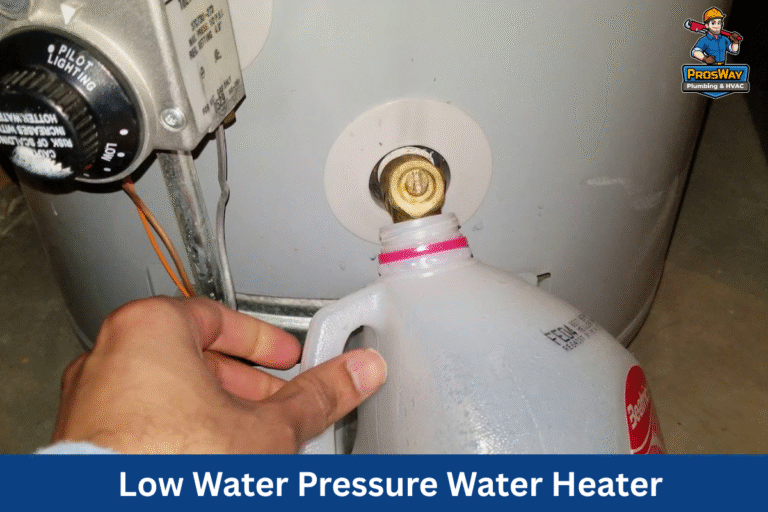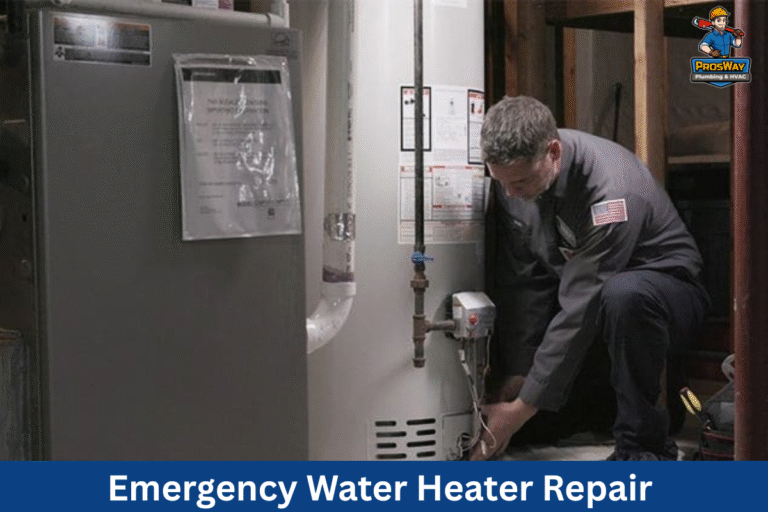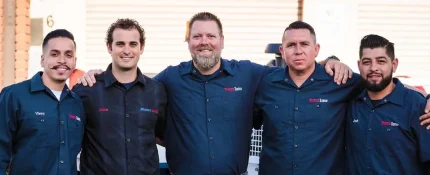Trenchless pipe replacement is gaining popularity among Northern New Jersey homeowners for good reason—it’s faster, less invasive, and more efficient than traditional methods.
At ProsWay Plumbing & HVAC, we’ve seen firsthand how advanced technology can streamline major repairs with minimal disruption to your home. By using modern techniques, we reduce downtime and deliver durable results.
This guide explains trenchless replacement vs. traditional digging in terms of work time, restoration needs, and project planning, helping you better understand what to expect.
What is the Typical Timeframe for Trenchless Pipe Replacement?
Trenchless pipe replacement minimizes impact by eliminating full-scale excavation. Most trenchless projects reduce downtime compared to traditional methods because they work without major disturbance to driveways and other site features.
In this section, we detail average trenchless durations and differences between pipe bursting and CIPP lining, while discussing factors that can accelerate the process.
Average Duration for Trenchless Sewer Line Projects
Trenchless projects are typically much faster than excavations. On average, a trenchless sewer line repair for a standard residential property takes between one to three days.
This includes planning, equipment mobilization, and completing the repair. The actual replacement often requires only four to eight hours, provided complications are minimal.
Preparation is streamlined through tools like CCTV and electronic mapping, which help engineers assess pipe conditions precisely.
For example, in a recent Parsippany project, our team replaced a failing cast iron sewer using trenchless methods in under eight hours—a job that traditional methods might extend over several days.
How Pipe Bursting Timelines Differ From CIPP Lining?
Pipe bursting involves breaking the old pipe while pulling in a new one and is generally faster, often completed in a single workday if access is clear. You can watch this video: Trenchless Sewer Replacement: How PIPE BURSTING Works.
In contrast, CIPP lining involves curing a resin-impregnated liner inside the old pipe; a curing period is necessary even with modern heat or steam acceleration techniques.
Thus, while pipe bursting is ideal for rapid turnaround, CIPP lining is beneficial for pipes with minor deformations or complex layouts. In both cases, on-site work time is significantly reduced compared to traditional excavations.
When Is Disruption the Least With Trenchless Work?
A key benefit of trenchless pipe replacement is minimal disruption. Traditional digging can damage driveways and lawns for days or weeks, whereas trenchless methods use small access points.
The result is faster site setup, minimal interruption of property use, and quick post-repair cleanups. Even if trenchless projects span several days for planning and inspections.
The active work phase is usually only a few hours, allowing homeowners to resume normal activities almost immediately.
This efficient scheduling further supports the appeal of trenchless technology, especially when minimizing daily inconvenience is essential.
Standard Duration of Traditional Pipe Replacement
Traditional pipe replacement, often called the “dig-and-replace” method, generally takes much longer than trenchless methods.
Homeowners choosing this method typically face extended disruption, higher property damage, and longer recovery periods.
It is important to know about the details, the time investment required for conventional methods, and how labor and landscape restoration increase overall duration.
What Is the Usual Timeline for Traditional Replacement?
The dig-and-replace method is a proven technique, but it is significantly more time-intensive. A conventional pipe replacement can take anywhere from five to ten days or longer depending on site conditions, pipe size, and weather.
This method involves the removal of large amounts of soil and requires additional restoration afterward. Even for simple residential repairs, excavation crews must work diligently to locate and remove the failing pipe, install the new one, and then backfill the trench.
The process involves multiple phases—excavation, soil compaction, and re-landscaping—each prone to delays and weather interruptions.
Furthermore, traditional methods require coordinated work between excavation teams, pipe installers, and landscape contractors.
Waiting for permits and coordinating schedules between different trades can extend the project even further, impacting driveways, sidewalks, and gardens.
How Does Excavation Affect Project Duration?
A major factor in the prolonged duration of traditional repairs is the extensive excavation needed. Digging deep and wide trenches may involve heavy equipment.
Unexpected challenges such as hard or rocky soil and undiscovered utilities can force crews to pause, re-evaluate, and adjust plans.
This careful shoring significantly extends the timeline. Property owners often experience considerable inconvenience during excavation, and the visual disruption and damage to landscaping can incur additional expenses.
The longer duration also increases the risk of issues like mold or water infiltration, prompting many to consider trenchless alternatives.
When Does Landscape Restoration Add Extra Time?
After traditional pipe replacement, restoring the property becomes a major task. Unlike trenchless methods, traditional repairs leave behind visible site disruptions that must be fixed.
Landscape restoration involves backfilling the excavation, compacting soil, and resurfacing driveways or sidewalks. In some cases, additional repairs to irrigation systems or planting new sod may be required.
Depending on the property’s complexity, this restoration can take from one to several days and may be further delayed by adverse weather.
For example, in a recent Morris County project, nearly a week of excavation was followed by three extra days of landscape restoration, significantly extending downtime.
What’s the Time Difference Between Trenchless and Traditional?

When comparing trenchless and traditional pipe replacement projects, the difference in overall completion times is striking.
Trenchless methods generally achieve a much faster turnaround due to reduced excavation, minimal cleanup, and fewer work phases.
In this section, we compare overall project times, active work time differences, and preparation/setup durations for both methods, and quantify the time saved by opting for the options.
Comparing Overall Project Completion Times Head-to-Head
Trenchless methods can often complete a repair within one to three days, while traditional approaches may take five to ten days or more.
For instance, a sewer repair in Parsippany using trenchless technology was finished in less than a day of active work, whereas similar repairs using excavation extended over several days.
These comparisons clearly demonstrate the advantage of trenchless processes in minimizing daily disruption and overall timeframe.
Examining the Active Work Time for Each Method
Active work time—the period during which the major repair occurs—is much shorter with trenchless methods. Typically ranging from four to eight hours, trenchless repairs eliminate long periods needed for excavation.
Traditional methods, however, often require 20 to 30 hours of active labor distributed among multiple crews across different phases.
The reduced active work time in trenchless repairs means faster project completion and lower overall labor costs, allowing homeowners to return to normal use of their property more quickly.
How do Preparation and Setup Times Vary Significantly?
Preparation and setup are also much quicker with trenchless techniques. Modern diagnostic tools and minimal site preparation mean that trenchless projects can be set up swiftly and with little disruption.
Traditional methods, in contrast, require clearing large areas, mobilizing heavy machinery, and sometimes rerouting traffic—each step adding significant time and complexity.
What Factors Affect Your Pipe Replacement Timeline?
Each pipe replacement project is unique, and several factors determine the actual time required. We break down how pipe diameter and length, and soil conditions.
Pipe material, permit delays, and contractor expertise influence project duration. This detailed analysis helps property owners set realistic expectations and plan accordingly.
Impact of Pipe Diameter and Length on Project Duration
The size and extent of your pipe system directly affect replacement time. Larger diameter pipes, especially those used for water supply or sewer systems, require advanced equipment and careful handling.
Longer pipes may need additional time for alignment and curing compared to smaller diameter pipes. For example, a 6-inch sewer line typically demands more precise work than a 2-inch water line.
How do Soil Conditions and Accessibility Influence Timelines?
Soil conditions are a major determinant of project time. In loose or sandy soils, equipment operates more quickly and access is easier, reducing work time.
In rocky, clay-heavy, or high water table areas, careful excavation or installation is necessary, which slows down progress.
Similarly, properties with easy access allow for faster work; narrow streets or confined spaces may force delays due to repositioning equipment or implementing additional safety measures.
The Role of Pipe Material in Replacement Speed
Different pipe materials affect repair speed. Traditional cast iron pipes, prone to corrosion and buildup, may require extensive cleaning or complete removal, leading to longer project times.
In contrast, modern materials like PVC or HDPE resist corrosion and can be installed faster using trenchless techniques.
The condition of the old pipe also plays a role; deteriorated cast iron may slow down, while modern resistant materials allow for a more straightforward process.
What Time-Saving Benefits Come With Trenchless Methods?

While speed is a major factor, trenchless methods offer additional time-related benefits that enhance overall efficiency and sustainability.
We discuss how trenchless solutions reduce downtime, minimize business interruptions, and provide long-term time savings through
How Does Trenchless Work Cut Property Downtime?
The most significant benefit of trenchless technology is the dramatically reduced downtime. Unlike traditional excavation, which renders driveways and entire neighborhoods inaccessible for days.
Trenchless repairs use small access points that allow homeowners to resume normal activities almost immediately. This quick return to functionality reduces indirect costs and minimizes inconvenience.
Minimizing Business Interruption Through Faster Replacement
For commercial properties, faster repair means less revenue loss and reduced customer disruption. For example, a local retail store in Morris County benefited from an overnight shutdown with trenchless repair.
In contrast to a full-week closure typically incurred by traditional methods. This fast turnaround is critical in urban settings, where every hour of downtime can significantly impact business performance.
Quicker Return to Normalcy for Homeowners
Homeowners value a quick return to everyday life. Trenchless repairs enable immediate use of the property without waiting for extensive landscape restoration.
This benefit reduces stress and avoids secondary issues that can arise from prolonged exposure to a disrupted environment, such as soil settlement or further pipe damage.
How do Less Invasive Methods Reduce Future Repair Times?
Trenchless pipe replacement is less invasive, meaning the surrounding environment suffers minimal disruption. This reduced impact helps prevent secondary issues.
Such as soil settlement or foundation damage, which can trigger additional repair work. The long-term benefits of a well-installed, trenchless system are significant in maintaining a sustainable repair cycle.
Frequently Asked Questions
How does trenchless pipe replacement reduce overall project time?
Trenchless replacement minimizes surface disruption, eliminating extensive excavation and restoration. This results in typical project durations of one to three days, compared to much longer timelines for traditional methods.
What factors influence the duration of a trenchless pipe repair?
Key factors include pipe diameter, length, material, soil conditions, accessibility, and contractor expertise. Effective planning, fast permit acquisition, and modern diagnostic tools also help minimize the project duration.
How do weather conditions affect trenchless versus traditional methods?
While weather can delay both methods, trenchless repairs are less affected because they involve minimal surface disturbance. Traditional excavation may be halted or slowed by adverse weather, prolonging restoration and overall completion.
Can trenchless methods be used for all types of pipes and failures?
Trenchless methods are highly effective for many sewer and water line issues. However, in cases of severe deterioration or highly unstable soils, traditional methods may still be necessary. A professional evaluation will determine the best approach.
How does the complexity of a piping layout affect repair time?
Complex layouts with multiple bends or intersections require more precise techniques and additional time, though trenchless methods adapt more quickly than traditional methods, which need extra excavation and restoration. Piping and repiping services can be essential in addressing these complexities.
What post-repair benefits do trenchless methods provide for future maintenance?
Trenchless repairs generally produce durable, long-lasting systems that lower the likelihood of future failures. With minimal disturbance to the surrounding area, there is reduced risk of property damage, leading to long-term time savings and reliability.
Final Thoughts
Trenchless pipe replacement provides a faster, less disruptive solution compared to traditional methods. Homeowners in Northern New Jersey benefit from reduced downtime, minimal property disruption, and long-term durability. If you are considering pipe replacement, opting for trenchless methods can significantly enhance efficiency while preserving the integrity and aesthetics of your property.
Ready to Save Time on Your Next Pipe Repair? Call ProsWay
Skip the mess and delays—choose trenchless pipe replacement with ProsWay Plumbing & HVAC. Our expert team delivers fast, clean, and reliable results across Northern New Jersey. Call us now at (862) 260-5870 or Book Online to schedule your inspection!









